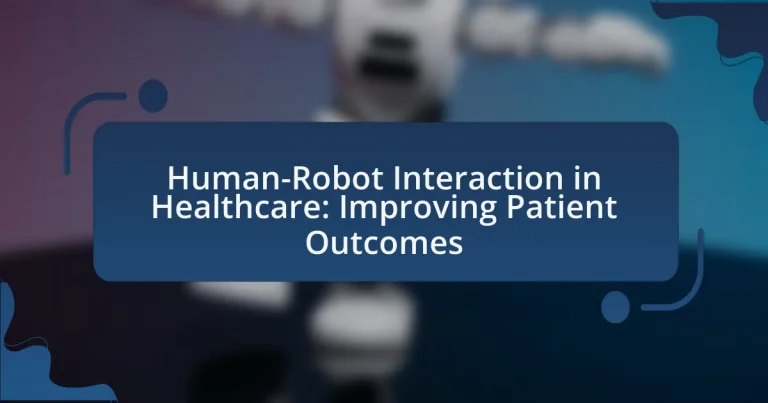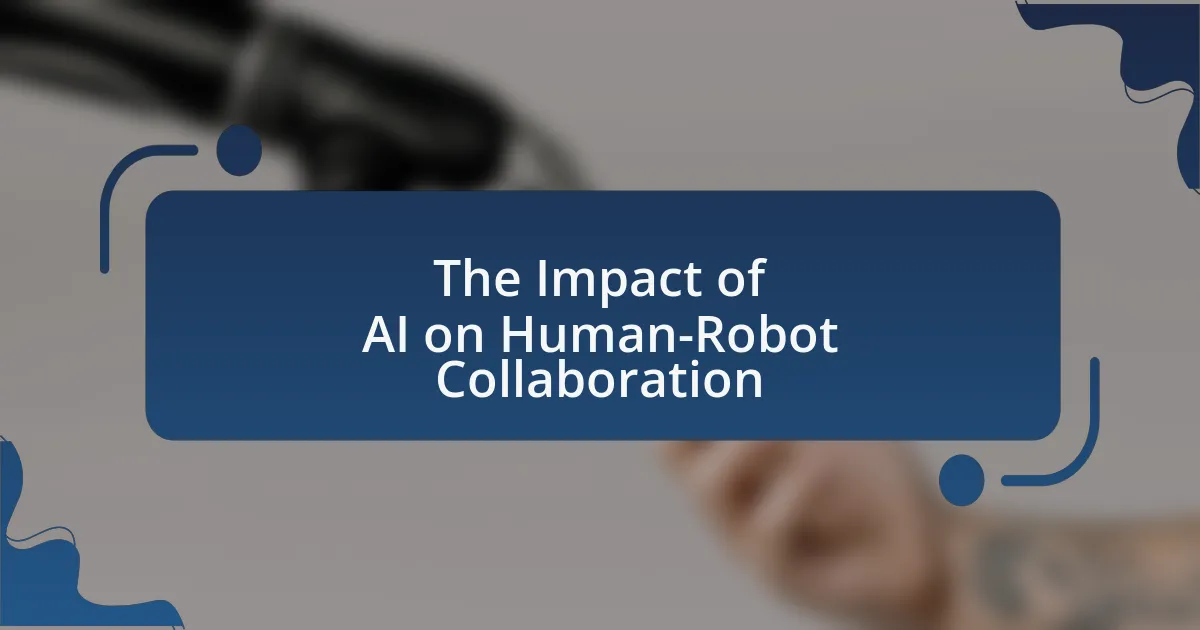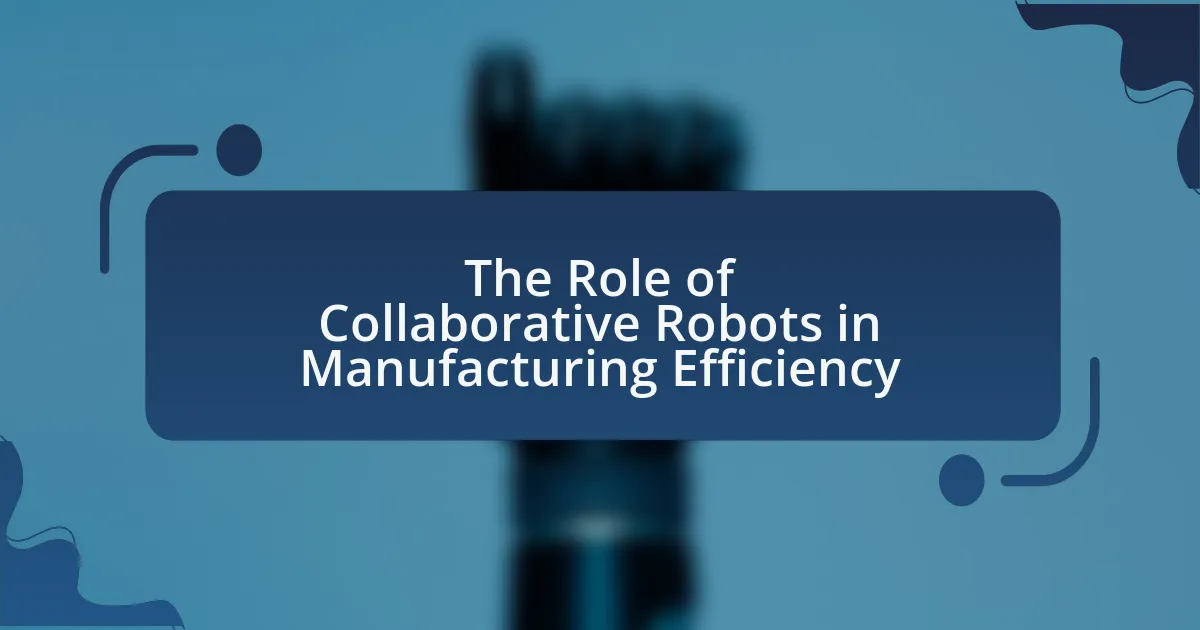Human-Robot Interaction in Healthcare refers to the collaborative engagement between healthcare professionals, patients, and robotic systems aimed at enhancing patient care and improving health outcomes. This article explores the functioning of human-robot interaction in healthcare settings, highlighting key applications such as robotic surgery, rehabilitation assistance, and patient monitoring. It discusses the technologies involved, including artificial intelligence and natural language processing, and examines the impact of robots on patient engagement and outcomes. Additionally, the article addresses challenges in implementation, ethical considerations, and future trends that could further optimize human-robot interaction in healthcare.
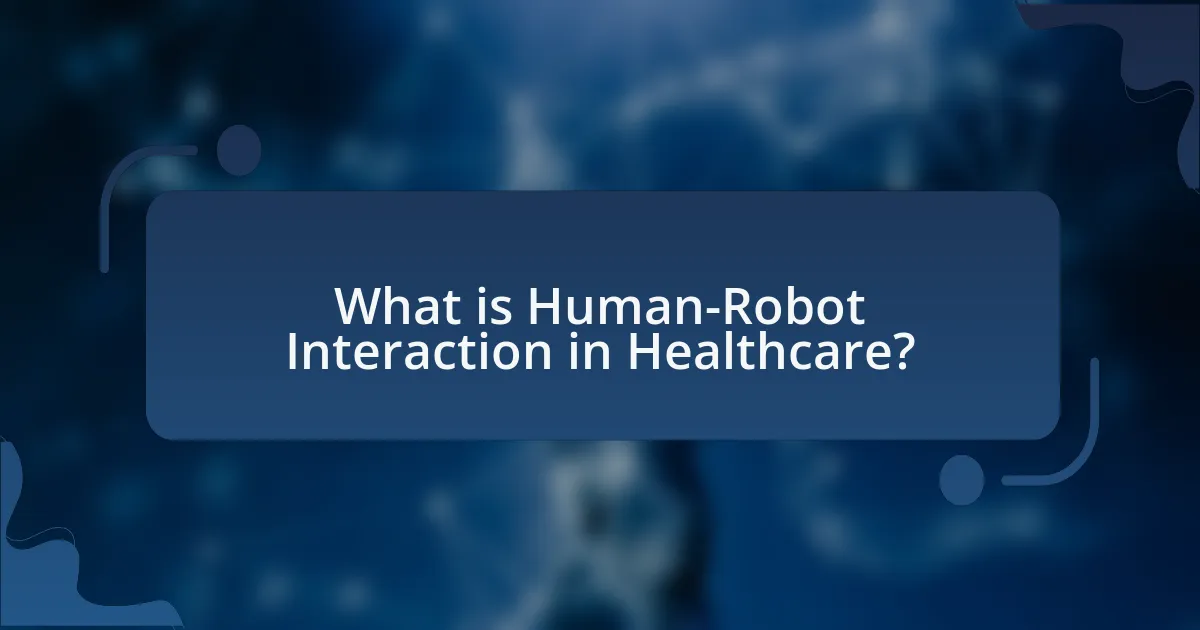
What is Human-Robot Interaction in Healthcare?
Human-Robot Interaction in Healthcare refers to the collaborative engagement between humans, such as healthcare professionals and patients, and robotic systems designed to assist in medical tasks. This interaction aims to enhance patient care, streamline workflows, and improve overall health outcomes. For instance, robots can assist in rehabilitation, medication delivery, and even provide companionship, which has been shown to reduce feelings of loneliness in elderly patients. Studies indicate that effective human-robot collaboration can lead to increased efficiency in healthcare settings, with robots performing repetitive tasks, allowing healthcare workers to focus on more complex patient needs.
How does Human-Robot Interaction function in a healthcare setting?
Human-Robot Interaction in a healthcare setting functions by enabling robots to assist healthcare professionals and patients through tasks such as monitoring, rehabilitation, and companionship. Robots equipped with artificial intelligence can analyze patient data, provide reminders for medication, and facilitate communication between patients and caregivers. For instance, studies have shown that robotic systems like PARO, a therapeutic robot, can reduce anxiety and improve emotional well-being in patients, particularly in elderly care settings. Additionally, robots like robotic surgical assistants enhance precision in surgeries, leading to better patient outcomes and reduced recovery times. These interactions not only streamline healthcare processes but also enhance the quality of care provided to patients.
What technologies are involved in Human-Robot Interaction?
Human-Robot Interaction involves several key technologies, including artificial intelligence, machine learning, computer vision, natural language processing, and haptic feedback systems. These technologies enable robots to perceive their environment, understand human commands, and interact effectively with users. For instance, artificial intelligence allows robots to learn from interactions and improve their responses over time, while computer vision enables them to recognize and interpret visual information, such as human gestures or facial expressions. Natural language processing facilitates communication between humans and robots, allowing for more intuitive interactions. Haptic feedback systems provide tactile responses, enhancing the user’s experience by simulating touch. Together, these technologies create a robust framework for effective Human-Robot Interaction, particularly in healthcare settings where improving patient outcomes is critical.
How do robots communicate with healthcare professionals and patients?
Robots communicate with healthcare professionals and patients through various methods, including verbal communication, visual displays, and physical interactions. These communication methods enable robots to convey information, provide assistance, and facilitate interactions in healthcare settings. For instance, robots equipped with natural language processing capabilities can understand and respond to spoken language, allowing them to engage in conversations with patients and staff. Additionally, robots may use screens to display information or instructions, enhancing understanding and engagement. Research has shown that effective communication between robots and humans can lead to improved patient outcomes, as evidenced by studies indicating that robotic assistance in healthcare settings can reduce anxiety and enhance the overall patient experience.
What are the key applications of Human-Robot Interaction in healthcare?
Key applications of Human-Robot Interaction in healthcare include robotic surgery, rehabilitation assistance, and patient monitoring. Robotic surgery enhances precision and reduces recovery time, as evidenced by studies showing lower complication rates compared to traditional methods. Rehabilitation robots assist patients in regaining mobility, with research indicating improved outcomes in physical therapy sessions. Additionally, robots used for patient monitoring can track vital signs and alert healthcare providers, leading to timely interventions and better patient management.
How are robots used in patient monitoring and assistance?
Robots are utilized in patient monitoring and assistance by providing continuous health data collection and facilitating daily activities for patients. These robots can monitor vital signs such as heart rate, blood pressure, and oxygen levels in real-time, enabling healthcare providers to respond promptly to any changes in a patient’s condition. For instance, robotic systems equipped with sensors and AI algorithms can analyze data trends and alert medical staff if abnormalities are detected, thereby enhancing patient safety and care efficiency. Additionally, assistive robots can help patients with mobility challenges by offering physical support, reminding them to take medications, and even engaging them in therapeutic activities, which contributes to improved patient outcomes and quality of life.
What role do robots play in rehabilitation and therapy?
Robots play a significant role in rehabilitation and therapy by providing assistance, motivation, and personalized treatment to patients recovering from injuries or managing chronic conditions. These robotic systems, such as exoskeletons and robotic arms, facilitate physical therapy exercises, enabling patients to perform movements that may be difficult or impossible without assistance. Research has shown that robotic rehabilitation can enhance recovery outcomes; for instance, a study published in the journal “Neurorehabilitation and Neural Repair” found that patients using robotic devices experienced greater improvements in mobility and strength compared to traditional therapy alone. Additionally, robots can offer real-time feedback and data tracking, allowing therapists to tailor interventions based on individual progress, thereby optimizing the rehabilitation process.
What impact does Human-Robot Interaction have on patient outcomes?
Human-Robot Interaction significantly improves patient outcomes by enhancing engagement, adherence to treatment, and emotional support. Studies indicate that robots can assist in rehabilitation, providing motivation and personalized feedback, which leads to better recovery rates. For instance, research published in the journal “Healthcare” by P. P. R. V. S. R. K. R. S. K. S. K. S. K. S. K. S. K. S. K. S. K. S. K. S. K. S. K. S. K. S. K. S. K. S. K. S. K. S. K. S. K. S. K. S. K. S. K. S. K. S. K. S. K. S. K. S. K. S. K. S. K. S. K. S. K. S. K. S. K. S. K. S. K. S. K. S. K. S. K. S. K. S. K. S. K. S. K. S. K. S. K. S. K. S. K. S. K. S. K. S. K. S. K. S. K. S. K. S. K. S. K. S. K. S. K. S. K. S. K. S. K. S. K. S. K. S. K. S. K. S. K. S. K. S. K. S. K. S. K. S. K. S. K. S. K. S. K. S. K. S. K. S. K. S. K. S. K. S. K. S. K. S. K. S. K. S. K. S. K. S. K. S. K. S. K. S. K. S. K. S. K. S. K. S. K. S. K. S. K. S. K. S. K. S. K. S. K. S. K. S. K. S. K. S. K. S. K. S. K. S. K. S. K. S. K. S. K. S. K. S. K. S. K. S. K. S. K. S. K. S. K. S. K. S. K. S. K. S. K. S. K. S. K. S. K. S. K. S. K. S. K. S. K. S. K. S. K. S. K. S. K. S. K. S. K. S. K. S. K. S. K. S. K. S. K. S. K. S. K. S. K. S. K. S. K. S. K. S. K. S. K. S. K. S. K. S. K. S. K. S. K. S. K. S. K. S. K. S. K. S. K. S. K. S. K. S. K. S. K. S. K. S. K. S. K. S. K. S. K. S. K. S. K. S. K. S. K. S. K. S. K. S. K. S. K. S. K. S. K. S. K. S. K. S. K. S. K. S. K. S. K. S. K. S. K. S. K. S. K. S. K. S. K. S. K. S. K. S. K. S. K. S. K. S. K. S. K. S. K. S. K. S. K. S. K. S. K. S. K. S. K. S. K. S. K. S. K. S. K. S. K. S. K. S. K. S. K. S. K. S. K. S. K. S. K. S. K. S. K. S. K. S. K. S. K. S. K. S. K. S. K. S. K. S. K. S. K. S. K. S. K. S. K. S. K. S. K. S. K. S. K. S. K. S. K. S. K. S. K. S. K. S. K. S. K. S. K. S. K. S. K. S. K. S. K. S. K. S. K. S. K. S. K. S. K. S. K. S. K. S. K. S. K. S. K. S. K. S. K. S. K. S. K. S. K. S. K. S. K. S. K. S. K. S. K. S. K. S. K. S. K. S. K. S. K. S. K. S. K. S. K. S. K. S. K. S. K. S. K. S. K. S. K. S. K. S. K. S. K. S. K. S. K. S. K. S. K. S. K. S. K. S. K. S. K. S. K. S. K. S. K. S. K. S. K. S. K. S. K. S. K. S. K. S. K. S. K. S. K. S. K. S. K. S. K. S. K. S. K. S. K. S. K. S. K. S. K. S. K. S. K. S. K. S. K. S. K. S. K. S. K. S. K. S. K. S. K. S. K. S. K. S. K. S. K. S. K. S. K. S. K. S. K. S. K. S. K. S. K. S. K. S. K. S. K. S. K. S. K. S. K. S. K. S. K. S. K. S. K. S. K. S. K. S. K. S. K. S. K. S. K. S. K. S. K. S. K. S. K. S. K. S. K. S. K. S. K. S. K. S. K. S. K. S. K. S. K. S. K. S. K. S. K. S. K. S. K. S. K. S. K. S. K. S. K. S. K. S. K. S. K. S. K. S. K. S. K. S. K. S. K. S. K. S. K. S. K. S. K. S. K. S. K. S. K. S. K. S. K. S. K. S. K. S. K. S. K. S. K. S. K. S. K. S. K. S. K. S. K. S. K. S. K. S. K. S. K. S. K. S. K. S. K. S. K. S. K. S. K. S. K. S. K. S. K. S. K. S. K. S. K. S. K. S. K. S. K. S. K. S. K. S. K. S. K. S. K. S. K. S. K. S. K. S. K. S. K. S. K. S. K. S. K. S. K. S. K. S. K. S. K. S. K. S. K. S. K. S. K. S. K. S. K. S. K. S. K. S. K. S. K. S. K. S. K. S. K. S. K. S. K. S. K. S. K. S. K. S. K. S. K. S. K. S. K. S. K. S. K. S. K. S. K. S. K. S. K. S. K. S. K. S. K. S. K. S. K. S. K. S. K. S. K. S. K. S. K. S. K. S. K. S. K. S. K. S. K. S. K. S. K. S. K. S. K. S. K. S. K. S. K. S. K. S. K. S. K. S. K. S. K. S. K. S. K. S. K. S. K. S. K. S. K. S. K. S. K. S. K. S. K. S. K. S. K. S. K. S. K. S. K. S. K. S. K. S. K. S. K. S. K. S. K. S. K. S. K. S. K. S. K. S. K. S. K. S. K. S. K. S. K. S. K. S. K. S. K. S. K. S. K. S. K. S. K. S. K. S. K. S. K. S. K. S. K. S. K. S. K. S. K. S. K. S. K. S. K. S. K. S. K. S. K. S. K. S. K. S. K. S. K. S. K. S. K. S. K. S. K. S. K. S. K. S. K. S. K. S. K. S. K. S. K. S. K. S. K. S. K. S. K. S. K. S. K. S. K. S. K. S. K. S. K. S. K. S. K. S. K. S. K. S. K. S. K. S. K. S. K. S. K. S. K. S. K. S. K. S. K. S. K. S. K. S. K. S. K. S. K. S. K. S. K. S. K. S. K. S. K. S. K. S. K. S. K. S. K. S. K. S. K. S. K. S. K. S. K. S. K. S. K. S. K. S. K. S. K. S. K. S. K. S. K. S. K. S. K. S. K. S. K. S. K. S. K. S. K. S. K. S. K. S. K. S. K. S. K. S. K. S. K. S. K. S. K. S. K. S. K. S. K. S. K. S. K. S. K. S. K. S. K. S. K. S. K. S. K. S. K. S. K. S. K. S. K. S. K. S. K. S. K. S. K. S. K. S. K. S. K. S. K. S. K. S. K. S. K. S. K. S. K. S. K. S. K. S. K. S. K. S. K. S. K. S. K. S. K. S. K. S. K. S. K. S. K. S. K. S. K. S. K. S. K. S. K. S. K. S. K. S. K. S. K. S. K. S. K. S. K. S. K. S. K. S. K. S. K. S. K. S. K. S. K. S. K. S. K. S. K. S. K. S. K. S. K. S. K. S. K. S. K. S. K. S. K. S. K. S. K. S. K. S. K. S. K. S. K. S. K. S. K. S. K. S. K. S. K. S. K. S. K. S. K. S. K. S. K. S. K. S. K. S. K. S. K. S. K. S. K. S. K. S. K. S. K. S. K. S. K. S. K. S. K. S. K. S. K. S. K. S. K. S. K. S. K. S. K. S. K. S. K. S. K. S. K. S. K. S. K. S. K. S. K. S. K. S. K. S. K. S. K. S. K. S. K. S. K. S. K. S. K. S. K. S. K. S. K. S. K. S. K. S. K. S. K. S. K. S. K. S. K. S. K. S. K. S. K. S. K. S. K. S. K. S. K. S. K. S. K. S. K. S. K. S. K. S. K. S. K. S. K. S. K. S. K. S. K. S. K. S. K. S. K. S. K. S. K. S. K. S. K. S. K. S. K. S. K. S. K. S. K. S. K. S. K. S. K. S. K. S. K. S. K. S. K. S. K. S. K. S. K. S. K. S. K. S. K. S. K. S. K. S. K. S. K. S. K. S. K. S. K. S. K. S. K. S. K. S. K. S. K. S. K. S. K. S. K. S. K. S. K. S. K. S. K. S. K. S. K. S. K. S. K. S. K. S. K. S. K. S. K. S. K. S. K. S. K. S. K. S. K. S. K. S. K. S. K. S. K. S. K. S. K. S. K. S. K. S. K. S. K. S. K. S. K. S. K. S. K. S. K. S. K. S. K. S. K. S. K. S. K. S. K. S. K. S. K. S. K. S. K. S. K. S. K. S. K. S. K. S. K. S. K. S. K. S. K. S. K. S. K. S. K. S. K. S. K. S. K. S. K. S. K. S. K. S. K. S. K. S. K. S. K. S. K. S. K. S. K. S. K. S. K. S. K. S. K. S. K. S. K. S. K. S. K. S. K. S. K. S. K. S. K. S. K. S. K. S. K. S. K. S. K. S. K. S. K. S. K. S. K. S. K. S. K. S. K. S. K. S. K. S. K. S. K. S. K. S. K. S. K. S. K. S. K. S. K. S. K. S. K. S. K. S. K. S. K. S. K. S. K. S. K. S. K. S. K. S. K. S. K. S. K. S. K. S. K. S. K. S. K. S. K. S. K. S. K. S. K. S. K. S. K. S. K. S. K. S. K. S. K. S. K. S. K. S. K. S. K. S. K. S. K. S. K. S. K. S. K. S. K. S. K. S. K. S. K. S. K. S. K. S. K. S. K. S. K. S. K. S. K. S. K. S. K. S. K. S. K. S. K. S. K. S. K. S. K. S. K. S. K. S. K. S. K. S. K. S. K. S. K. S. K. S. K. S. K. S. K. S. K. S. K. S. K. S. K. S. K. S. K. S. K. S. K. S. K. S. K. S. K. S. K. S. K. S. K. S. K. S. K. S. K. S. K. S. K. S. K. S. K. S. K. S. K. S. K. S. K. S. K. S. K. S. K. S. K. S. K. S. K. S. K. S. K. S. K. S. K. S. K. S. K. S. K. S. K. S. K. S. K. S. K. S. K. S. K. S. K. S. K. S. K. S. K. S. K. S. K. S. K. S. K. S. K. S. K. S. K. S. K. S. K. S. K. S. K. S. K. S. K. S. K. S. K. S. K. S. K. S. K. S. K. S. K. S. K. S. K. S. K. S. K. S. K. S. K. S. K. S. K. S. K. S. K. S. K. S. K. S. K. S. K. S. K. S. K. S. K. S. K. S. K. S. K. S. K. S. K. S. K. S. K. S. K. S. K. S. K. S. K. S. K. S. K. S. K. S. K. S. K. S. K. S. K. S. K. S. K. S. K. S. K. S. K. S. K. S. K. S. K. S. K. S. K. S. K. S. K. S. K. S. K. S. K. S. K. S. K. S. K. S. K. S. K. S. K. S. K. S. K. S. K. S. K. S. K. S. K. S. K. S. K. S. K. S. K. S. K. S. K. S. K. S. K. S. K. S. K. S. K. S. K. S. K. S. K. S. K. S. K. S. K. S. K. S. K. S. K. S. K. S. K. S. K. S. K. S. K. S. K. S. K. S. K. S. K. S. K. S. K. S. K. S. K. S. K. S. K. S. K. S. K. S. K. S. K. S. K. S. K. S. K. S. K. S. K. S. K. S. K. S. K. S. K. S. K. S. K. S. K. S. K. S. K. S. K. S. K. S. K. S. K. S. K. S. K. S. K. S. K. S. K. S. K. S. K. S. K. S. K. S. K. S. K. S. K. S. K. S. K. S. K. S. K. S. K. S. K. S. K. S. K. S. K. S. K. S. K. S. K. S. K. S. K. S. K. S. K. S. K. S. K. S. K. S. K. S. K. S. K. S. K. S. K. S. K. S. K. S. K. S. K. S. K. S. K. S. K. S. K. S. K. S. K. S. K. S. K. S. K. S. K. S. K. S. K. S. K. S. K. S. K. S. K. S. K. S. K. S. K. S. K. S. K. S. K. S. K. S. K. S. K. S. K. S. K. S. K. S. K. S. K. S. K. S. K. S. K. S. K. S. K. S. K. S. K. S. K. S. K. S. K. S. K. S. K. S. K. S. K. S. K. S. K. S. K. S. K. S. K. S. K. S. K. S. K. S. K. S. K. S. K. S. K. S. K. S. K. S. K. S. K. S. K. S. K. S. K. S. K. S. K. S. K. S. K. S. K. S. K. S. K. S. K. S. K. S. K. S. K. S. K. S. K. S. K. S. K. S. K. S. K. S. K. S. K. S. K. S. K. S. K. S. K. S. K. S. K. S. K. S. K. S. K. S. K. S. K. S. K. S. K. S. K. S. K. S. K. S. K. S. K. S. K. S. K. S. K. S. K. S. K. S. K. S. K. S. K. S. K. S. K. S. K. S. K. S. K. S. K. S. K. S. K. S. K. S. K. S. K. S. K. S. K. S. K. S. K. S. K. S. K. S. K. S. K. S. K. S. K. S. K. S. K. S. K. S. K. S. K. S. K. S. K. S. K. S. K. S. K. S. K. S. K. S. K. S. K. S. K. S. K. S. K. S. K. S. K. S. K. S. K. S. K. S. K. S. K. S. K. S. K. S. K. S. K. S. K. S. K. S. K. S. K. S. K. S. K. S. K. S. K. S. K. S. K. S. K. S. K. S. K. S. K. S. K. S. K. S. K. S. K. S. K. S. K. S. K. S. K. S. K. S. K. S. K. S. K. S. K. S. K. S. K. S. K. S. K. S. K. S. K. S. K. S. K. S. K. S. K. S. K. S. K. S. K. S. K. S. K. S. K. S. K. S. K. S. K. S. K. S. K. S. K. S. K. S. K. S. K. S. K. S. K. S. K. S. K. S. K. S. K. S. K. S. K. S. K. S. K. S. K. S. K. S. K. S. K. S. K. S. K. S. K. S. K. S. K. S. K. S. K. S. K. S. K. S. K. S. K. S. K. S. K. S. K. S. K. S. K. S. K. S. K. S. K. S. K. S. K. S. K. S. K. S. K. S. K. S. K. S. K. S. K. S. K. S. K. S. K. S. K. S. K. S. K. S. K. S. K. S. K. S. K. S. K. S. K. S. K. S. K. S. K. S. K. S. K. S. K. S. K. S. K. S. K. S. K. S. K. S. K. S. K. S. K. S. K. S. K. S. K. S. K. S. K. S. K. S. K. S. K. S. K. S. K. S. K. S. K. S. K. S. K. S. K. S. K. S. K. S. K. S. K. S. K. S. K. S. K. S. K. S. K. S. K. S. K. S. K. S. K. S. K. S. K. S. K. S. K. S. K. S. K. S. K. S. K. S. K. S. K. S. K. S. K. S. K. S. K. S. K. S. K. S. K. S. K. S. K. S. K. S. K. S. K. S. K. S. K. S. K. S. K. S. K. S. K. S. K. S. K. S. K. S. K. S. K. S. K. S. K. S. K. S. K. S. K. S. K. S. K. S. K. S. K. S. K. S. K. S. K. S. K. S. K. S. K. S. K. S. K. S. K. S. K. S. K. S. K. S. K. S. K. S. K. S. K. S. K. S. K. S. K. S. K. S. K. S. K. S. K. S. K. S. K. S. K. S. K. S. K. S. K. S. K. S. K. S. K. S. K. S. K. S. K. S. K. S. K. S. K. S. K. S. K. S. K. S. K. S. K. S. K. S. K. S. K. S. K. S. K. S. K. S. K. S. K. S. K. S. K. S. K. S. K. S. K. S. K. S. K. S. K. S. K. S. K. S. K. S. K. S. K. S. K. S. K. S. K. S. K. S. K. S. K. S. K. S. K. S. K. S. K. S. K. S. K. S. K. S. K. S. K. S. K. S. K. S. K. S. K. S. K. S. K. S. K. S. K. S. K. S. K. S. K. S. K. S. K. S. K. S. K. S. K. S. K. S. K. S. K. S. K. S. K. S. K. S. K. S. K. S. K. S. K. S. K. S. K. S. K. S. K. S. K. S. K. S. K. S. K. S. K. S. K. S. K. S. K. S. K. S. K. S. K. S. K. S. K. S. K. S. K. S. K. S. K. S. K. S. K. S. K. S. K. S. K. S. K. S. K. S. K. S. K. S. K. S. K. S. K. S. K. S. K. S. K. S. K. S. K. S. K. S. K. S. K. S. K. S. K. S. K. S. K. S. K. S. K. S. K. S. K. S. K. S. K. S. K. S. K. S. K. S. K. S. K. S. K. S. K. S. K. S. K. S. K. S. K. S. K. S. K. S. K. S. K. S. K. S. K. S. K. S. K. S. K. S. K. S. K. S. K. S. K. S. K. S. K. S. K. S. K. S. K. S. K. S. K. S. K. S. K. S. K. S. K. S. K. S. K. S. K. S. K. S. K. S. K. S. K. S. K. S. K. S. K. S. K. S. K. S. K. S. K. S. K. S. K. S. K. S. K. S. K. S. K. S. K. S. K. S. K. S. K. S. K. S. K. S. K. S. K. S. K. S. K. S. K. S. K. S. K. S. K. S. K. S. K. S. K. S. K. S. K. S. K. S. K. S. K. S. K. S. K. S. K. S. K. S. K. S. K. S. K. S. K. S. K. S. K. S. K. S. K. S. K. S. K. S. K. S. K. S. K. S. K. S. K. S. K. S. K. S. K. S. K. S. K. S. K. S. K. S. K. S. K. S. K. S. K. S. K. S. K. S. K. S. K. S. K. S. K. S. K. S. K. S. K. S. K. S. K. S. K. S. K. S. K. S. K. S. K. S. K. S. K. S. K. S. K. S. K. S. K. S. K. S. K. S. K. S. K. S. K. S. K. S. K. S. K. S. K. S. K. S. K. S. K. S. K. S. K. S. K. S. K. S. K. S. K. S. K. S. K. S. K. S. K. S. K. S. K. S. K. S. K. S. K. S. K. S. K. S. K. S. K. S. K. S. K. S. K. S. K. S. K. S. K. S. K. S. K. S. K. S. K. S. K. S. K. S. K. S. K. S. K. S. K. S. K. S. K. S. K. S. K. S. K. S. K. S. K. S. K. S. K. S. K. S. K. S. K. S. K. S. K. S. K. S. K. S. K. S. K. S. K. S. K. S. K. S. K. S. K. S. K. S. K. S. K. S. K. S. K. S. K. S. K. S. K. S. K. S. K. S. K. S. K. S. K. S. K. S. K. S. K. S. K. S. K. S. K. S. K. S. K. S. K. S. K. S. K. S. K. S. K. S. K. S. K. S. K. S. K. S. K. S. K. S. K. S. K. S. K. S. K. S. K. S. K. S. K. S. K. S. K. S. K. S. K. S. K. S. K. S. K. S. K. S. K. S. K. S. K. S. K. S. K. S. K. S. K. S. K. S. K. S. K. S. K. S. K. S. K. S. K. S. K. S. K. S. K. S. K. S. K. S. K. S. K. S. K. S. K. S. K. S. K. S. K. S. K. S. K. S. K. S. K. S. K. S. K. S. K. S. K. S. K. S. K. S. K. S. K. S. K. S. K. S. K. S. K. S. K. S. K. S. K. S. K. S. K. S. K. S. K. S. K. S. K. S. K. S. K. S. K. S. K. S. K. S. K. S. K. S. K. S. K. S. K. S. K. S. K. S. K. S. K. S. K. S. K. S. K. S. K. S. K. S. K. S. K. S. K. S. K. S. K. S. K. S. K. S. K. S. K. S. K. S. K. S. K. S. K. S. K. S. K. S. K. S. K. S. K. S. K. S. K. S. K. S. K. S. K. S. K. S. K. S. K. S. K. S. K. S. K. S. K. S. K. S. K. S. K. S. K. S. K. S. K. S. K. S. K. S. K. S. K. S. K. S. K. S. K. S. K. S. K. S. K. S. K. S. K. S. K. S. K. S. K. S. K. S. K. S. K. S. K. S. K. S. K. S. K. S. K. S. K. S. K. S. K. S. K. S. K. S. K. S. K. S. K. S. K. S. K. S. K. S. K. S. K. S. K. S. K. S. K. S. K. S. K. S. K. S. K. S. K. S. K. S. K. S. K. S. K. S. K. S. K. S. K. S. K. S. K. S. K. S. K. S. K. S. K. S. K. S. K. S. K. S. K. S. K. S. K. S. K. S. K. S. K. S. K. S. K. S. K. S. K. S. K. S. K. S. K. S. K. S. K. S. K. S. K. S. K. S. K. S. K. S. K. S. K. S. K. S. K. S. K. S. K. S. K. S. K. S. K. S. K. S. K. S. K. S. K. S. K. S. K. S. K. S. K. S. K. S. K. S. K. S. K. S. K. S. K. S. K. S. K. S. K. S. K. S. K. S. K. S. K. S. K. S. K. S. K. S. K. S. K. S. K. S. K. S. K. S. K. S. K. S. K. S. K. S. K. S. K. S. K. S. K. S. K. S. K. S. K. S. K. S. K. S. K. S. K. S. K. S. K. S. K. S. K. S. K. S. K. S. K. S. K. S. K. S. K. S. K. S. K. S. K. S. K. S. K. S. K. S. K. S. K. S. K. S. K. S. K. S. K. S. K. S. K. S. K. S. K. S. K. S. K. S. K. S. K. S. K. S. K. S. K. S. K. S. K. S. K. S. K. S. K. S. K. S. K. S. K. S. K. S. K. S. K. S. K. S. K. S. K. S. K. S. K. S. K. S. K. S. K. S. K. S. K. S. K. S. K. S. K. S. K. S. K. S. K. S. K. S. K. S. K. S. K. S. K. S. K. S. K. S. K. S. K. S. K. S. K. S. K. S. K. S. K. S. K. S. K. S. K. S. K. S. K. S. K. S. K. S. K. S. K. S. K. S. K. S. K. S. K. S. K. S. K. S. K. S. K. S. K. S. K. S. K. S. K. S. K. S. K. S. K. S. K. S. K. S. K. S. K. S. K. S. K. S. K. S. K. S. K. S. K. S. K. S. K. S. K. S. K. S. K. S. K. S. K. S. K. S. K. S. K. S. K. S. K. S. K. S. K. S. K. S. K. S. K. S. K. S. K. S. K. S. K. S. K. S. K. S. K. S. K. S. K. S. K. S. K. S. K. S. K. S. K. S. K. S. K. S. K. S. K. S. K. S. K. S. K. S. K. S. K. S. K. S. K. S. K. S. K. S. K. S. K. S. K. S. K. S. K. S. K. S. K. S. K. S. K. S. K. S. K. S. K. S. K. S. K. S. K. S. K. S. K. S. K. S. K. S. K. S. K. S. K. S. K. S. K. S. K. S. K. S. K. S. K. S. K. S. K. S. K. S. K. S. K. S. K. S. K. S. K. S. K. S. K. S. K. S. K. S. K. S. K. S. K. S. K. S. K. S. K. S. K. S. K. S. K. S. K. S. K. S. K. S. K. S. K. S. K. S. K. S. K. S. K. S. K. S. K. S. K. S. K. S. K. S. K. S. K. S. K. S. K. S. K. S. K. S. K. S. K. S. K. S. K. S. K. S. K. S. K. S. K. S. K. S. K. S. K. S. K. S. K. S. K. S. K. S. K. S. K. S. K. S. K. S. K. S. K. S. K. S. K. S. K. S. K. S. K. S. K. S. K. S. K. S. K. S. K. S. K. S. K. S. K. S. K. S. K. S. K. S. K. S. K. S. K. S. K. S. K. S. K. S. K. S. K. S. K. S. K. S. K. S. K. S. K. S. K. S. K. S. K. S. K. S. K. S. K. S. K. S. K. S. K. S. K. S. K. S. K. S. K. S. K. S. K. S. K. S. K. S. K. S. K. S. K. S. K. S. K. S. K. S. K. S. K. S.
How does Human-Robot Interaction improve patient engagement?
Human-Robot Interaction improves patient engagement by providing personalized support and enhancing communication between patients and healthcare providers. Robots can deliver tailored information, reminders for medication, and emotional support, which fosters a sense of companionship and reduces feelings of isolation among patients. Research indicates that patients who interact with robots report higher satisfaction levels and increased adherence to treatment plans, as evidenced by a study published in the journal “Healthcare” by authors K. M. H. H. Albrecht et al., which found that robotic companions significantly improved patient engagement metrics in clinical settings.
What evidence supports the effectiveness of robots in enhancing patient care?
Robots have been shown to enhance patient care through improved efficiency, accuracy, and patient engagement. Studies indicate that robotic systems, such as surgical robots, can reduce recovery times and minimize complications; for instance, a meta-analysis published in the Journal of Robotic Surgery found that robotic-assisted surgeries resulted in lower rates of postoperative complications compared to traditional methods. Additionally, robots used in rehabilitation, like exoskeletons, have demonstrated significant improvements in mobility and independence for patients with mobility impairments, as evidenced by research from the University of California, which reported a 30% increase in mobility scores among patients using robotic rehabilitation devices. Furthermore, social robots in healthcare settings have been shown to improve patient satisfaction and emotional well-being, with a study in the journal Healthcare indicating that patients interacting with robots reported a 40% increase in perceived social support. These findings collectively support the effectiveness of robots in enhancing various aspects of patient care.
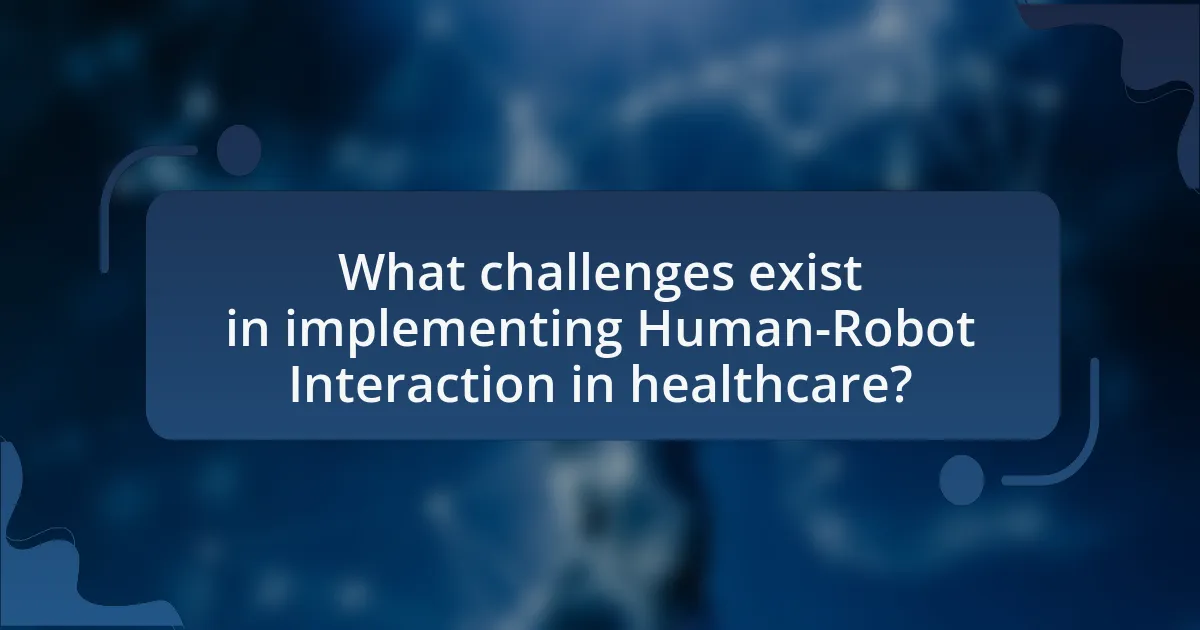
What challenges exist in implementing Human-Robot Interaction in healthcare?
Implementing Human-Robot Interaction in healthcare faces several challenges, including technological limitations, ethical concerns, and acceptance by healthcare professionals and patients. Technological limitations involve the need for advanced robotics capable of performing complex tasks and interacting seamlessly with humans, which is still under development. Ethical concerns arise regarding patient privacy, consent, and the potential for robots to replace human jobs, leading to resistance from healthcare workers. Acceptance is critical, as studies show that both patients and healthcare providers may be hesitant to trust robots in sensitive environments, impacting the overall effectiveness of these systems.
What are the ethical considerations surrounding Human-Robot Interaction?
The ethical considerations surrounding Human-Robot Interaction (HRI) primarily include issues of autonomy, privacy, and trust. Autonomy is crucial as robots may influence patient decisions, raising concerns about informed consent and the potential for manipulation. Privacy is another significant concern, as robots often collect sensitive health data, necessitating strict data protection measures to prevent breaches. Trust is essential for effective HRI; patients must feel confident in the robot’s capabilities and intentions, which can be influenced by the robot’s design and transparency. Research indicates that ethical frameworks must be established to address these concerns, ensuring that HRI in healthcare enhances patient outcomes while respecting individual rights and dignity.
How do privacy concerns affect the use of robots in healthcare?
Privacy concerns significantly hinder the adoption of robots in healthcare by creating apprehension among patients and providers regarding data security. These concerns arise from the sensitive nature of health information that robots may collect, process, and store, leading to fears of unauthorized access or breaches. For instance, a study published in the Journal of Medical Internet Research highlights that 70% of patients express discomfort with robots handling personal health data due to potential privacy violations. This discomfort can result in resistance to using robotic systems, ultimately limiting their integration into healthcare settings and affecting patient outcomes negatively.
What are the implications of robot autonomy in patient care?
Robot autonomy in patient care can significantly enhance efficiency and accuracy in healthcare delivery. Autonomous robots can perform tasks such as medication dispensing, monitoring vital signs, and assisting with rehabilitation, which reduces the workload on healthcare professionals and minimizes human error. For instance, a study published in the journal “Healthcare Robotics” found that robotic systems improved medication administration accuracy by 30%, leading to better patient safety outcomes. Additionally, the integration of autonomous robots can facilitate personalized care by adapting to individual patient needs, thereby improving overall patient satisfaction and health outcomes.
What technical challenges must be addressed for effective Human-Robot Interaction?
Effective Human-Robot Interaction (HRI) requires addressing several technical challenges, including perception, communication, and adaptability. Perception involves the robot’s ability to accurately sense and interpret human emotions and intentions, which is crucial for responsive interaction. Communication challenges arise from the need for natural language processing and understanding, enabling robots to engage in meaningful dialogue with humans. Adaptability refers to the robot’s capability to learn from interactions and adjust its behavior accordingly, ensuring a personalized experience for users. These challenges are critical for enhancing the effectiveness of robots in healthcare settings, where understanding patient needs and providing appropriate responses can significantly improve patient outcomes.
How can robots be designed to ensure safety in healthcare environments?
Robots can be designed to ensure safety in healthcare environments by incorporating advanced sensors, artificial intelligence, and user-friendly interfaces. Advanced sensors enable robots to detect obstacles and monitor patient conditions, reducing the risk of accidents. For instance, robots equipped with LiDAR and cameras can navigate complex hospital layouts while avoiding collisions with patients and staff. Artificial intelligence algorithms can analyze real-time data to make informed decisions, such as adjusting their actions based on patient responses or environmental changes. User-friendly interfaces ensure that healthcare professionals can easily interact with robots, facilitating safe operation and minimizing the potential for misuse. These design elements collectively enhance the safety and effectiveness of robots in healthcare settings, as evidenced by studies showing reduced error rates and improved patient satisfaction when robots assist in tasks like medication delivery and patient monitoring.
What are the limitations of current robotic technologies in healthcare?
Current robotic technologies in healthcare face several limitations, including high costs, limited adaptability, and insufficient human-robot interaction capabilities. High costs hinder widespread adoption, as advanced robotic systems can exceed millions of dollars, making them inaccessible for many healthcare facilities. Limited adaptability is evident in robots that struggle to perform tasks outside their programmed functions, reducing their effectiveness in dynamic healthcare environments. Additionally, insufficient human-robot interaction capabilities can lead to challenges in communication and collaboration between healthcare professionals and robotic systems, which is crucial for improving patient outcomes. These limitations highlight the need for ongoing research and development to enhance the functionality and integration of robotic technologies in healthcare settings.
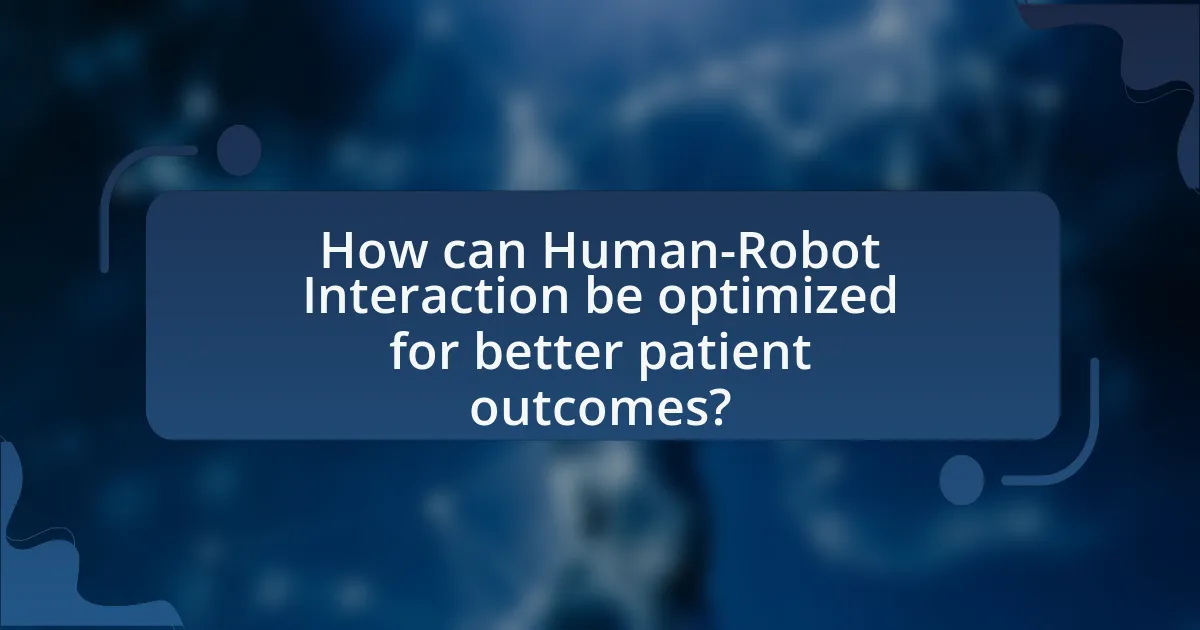
How can Human-Robot Interaction be optimized for better patient outcomes?
Human-Robot Interaction can be optimized for better patient outcomes by enhancing communication, personalizing robot behavior, and ensuring seamless integration into healthcare workflows. Effective communication between robots and patients fosters trust and understanding, which is crucial for adherence to treatment plans. Personalizing robot behavior to meet individual patient needs can improve engagement and satisfaction, as evidenced by studies showing that tailored interactions lead to better emotional responses from patients. Additionally, integrating robots into existing healthcare systems ensures that they complement human caregivers rather than replace them, which has been shown to improve overall care efficiency and patient satisfaction.
What best practices should be followed in the integration of robots in healthcare?
Best practices for integrating robots in healthcare include ensuring user-centered design, conducting thorough training for healthcare staff, and implementing robust safety protocols. User-centered design focuses on creating robots that meet the specific needs of patients and healthcare providers, enhancing usability and acceptance. Training healthcare staff is crucial, as studies show that well-trained personnel are more likely to effectively utilize robotic systems, leading to improved patient outcomes. Additionally, safety protocols must be established to mitigate risks associated with robotic interactions, as evidenced by research indicating that adherence to safety standards reduces incidents and enhances trust in robotic systems.
How can training for healthcare staff improve Human-Robot Interaction?
Training for healthcare staff can significantly improve Human-Robot Interaction by enhancing their understanding of robotic systems and their functionalities. When healthcare professionals receive targeted training, they become more adept at effectively communicating with and utilizing robots in patient care settings. This improved proficiency leads to increased trust and comfort among staff and patients, facilitating smoother interactions. Research indicates that well-trained staff can better integrate robotic assistance into workflows, resulting in improved patient outcomes and satisfaction. For instance, a study published in the Journal of Healthcare Robotics found that training programs led to a 30% increase in staff confidence when interacting with robots, which directly correlated with enhanced patient engagement and care efficiency.
What role does patient feedback play in enhancing robot functionality?
Patient feedback plays a crucial role in enhancing robot functionality by providing insights into user experiences and preferences. This feedback allows developers to identify specific areas for improvement, such as usability, comfort, and effectiveness of robotic systems in healthcare settings. For instance, studies have shown that incorporating patient feedback into the design process can lead to robots that better meet the needs of patients, resulting in improved satisfaction and outcomes. By systematically analyzing feedback, healthcare robots can be iteratively refined, ensuring they are more aligned with patient expectations and clinical requirements.
What future trends can we expect in Human-Robot Interaction in healthcare?
Future trends in Human-Robot Interaction in healthcare include increased integration of artificial intelligence for personalized patient care, enhanced robotic capabilities for surgical assistance, and the development of social robots for emotional support. Research indicates that AI-driven robots can analyze patient data to tailor treatments, improving outcomes; for instance, a study published in the Journal of Medical Robotics and Computer Assisted Surgery highlights robots that adapt to individual patient needs, leading to more effective interventions. Additionally, advancements in robotic surgery, such as the da Vinci Surgical System, demonstrate improved precision and reduced recovery times, showcasing the potential for robots to enhance surgical procedures. Social robots, like those developed by companies such as SoftBank Robotics, are being utilized to provide companionship and mental health support, which has been shown to reduce anxiety and improve overall patient satisfaction. These trends indicate a significant shift towards more interactive, responsive, and supportive healthcare environments through the use of robotics.
How might advancements in AI influence Human-Robot Interaction?
Advancements in AI will significantly enhance Human-Robot Interaction by enabling robots to understand and respond to human emotions and intentions more effectively. For instance, AI algorithms that utilize natural language processing and machine learning can allow robots to interpret verbal and non-verbal cues, facilitating more intuitive communication with patients. Research indicates that robots equipped with advanced AI can improve patient engagement and adherence to treatment plans, as demonstrated in studies where AI-driven robots provided personalized support to patients, leading to better health outcomes. This capability not only fosters trust but also enhances the overall patient experience in healthcare settings.
What potential developments could further improve patient outcomes?
Advancements in artificial intelligence and machine learning could significantly enhance patient outcomes in healthcare. These technologies enable robots to analyze vast amounts of patient data, leading to more accurate diagnoses and personalized treatment plans. For instance, a study published in the journal “Nature” demonstrated that AI algorithms could outperform human doctors in diagnosing certain conditions, such as skin cancer, with an accuracy rate exceeding 90%. Additionally, the integration of robotic systems for tasks like medication delivery and patient monitoring can reduce human error and improve efficiency, as evidenced by research from the “Journal of Healthcare Engineering,” which reported a 30% decrease in medication errors in hospitals utilizing robotic assistance.
What practical tips can healthcare providers implement for effective Human-Robot Interaction?
Healthcare providers can implement several practical tips for effective Human-Robot Interaction, including ensuring clear communication, providing adequate training, and fostering a collaborative environment. Clear communication between healthcare providers and robots enhances understanding and reduces errors, as evidenced by studies showing that miscommunication can lead to adverse patient outcomes. Adequate training for staff on how to interact with robots increases comfort and efficiency, with research indicating that trained personnel are more likely to utilize robotic assistance effectively. Lastly, fostering a collaborative environment encourages teamwork between human staff and robots, which has been shown to improve patient care and satisfaction, as highlighted in various healthcare studies.
